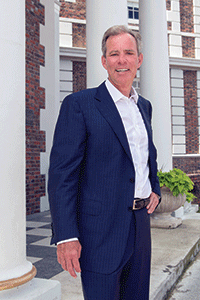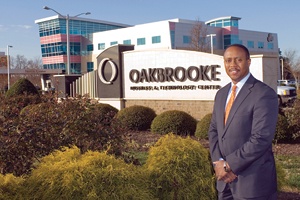Spiraling crime, poverty, dilapidated buildings, decrepit thoroughfares and an overall sense of despair have long defined Newport News’ East End.
Former NFL quarterback Aaron Brooks, however, has a plan to change that. The Newport News native, who grew up in East End public housing projects, has teamed with Virginia Beach developer Armada Hoffler
Properties and the Newport News Department of Economic Development on a $48.2 million revitalization project designed to pump energy and pride into the economically distressed neighborhood. Known as Brooks Crossing, the mixed-use development will encompass a 12-block area bordering Jefferson Avenue, once one of the city’s most prominent commercial corridors.
The ambitious undertaking was unveiled in 2008 but lay dormant during the recent recession. With improving financial markets, the project is back on track. Construction on the initial phase — a police precinct with 911 call center, a medical office building and a financial institution — is set to begin next spring. In preparation, the city has put up $11 million for street improvements, demolished obsolete public housing and renovated a century-old building into affordable residential units.
Although the full build-out will take nearly a decade, developers and city leaders believe the project will revitalize the East End and give a shot in the arm to development throughout the city. “Anytime you reinvigorate a section of the city, it helps the overall city,” says Lou Haddad, president and CEO of Armada Hoffler Properties.
Industrial leader
Located midway between Williamsburg and the Hampton Roads hub of Norfolk and Virginia Beach, Newport News is known for its “new blue-collar” environment. The city has the highest industrial base in Hampton Roads and statewide is second to Richmond in machinery and tool tax revenues. Many of its 180,700 residents work in skilled trades at Newport News Shipbuilding, Virginia’s largest industrial employer, and at manufacturers Canon Virginia Inc. and Liebherr Mining Equipment, which are expanding their local operations.
Economic development officials believe the city’s support for existing businesses is key to expansion. “We probably have in the last 15 to 20 years begun to see economic development as not just chasing businesses but making sure the community is attractive and ready for the type of development that will keep it moving forward and sustainable,” says Florence Kingston, the city’s economic development director. “Organic growth within the community and augmenting that with new businesses is more sustainable in the long run.”
Canon plans to spend $27 million to upgrade equipment and add employees, bringing its total capital investment in Newport News in the past four years to more than $371 million. Liebherr Mining Equipment, manufacturer of the world’s largest dump trucks, is spending more than $45 million to upgrade its plant infrastructure and will create 176 positions during the next four years.
With such a large industrial base, the city is more than 90 percent developed. That’s one reason officials are eager to get Brooks Crossing off the ground. “You’ve got to come back in and use these opportunities to clean up underdeveloped parts of the city,” Kingston says. “New construction and new business activity should restore pride and excitement in that community. Developments will be the stimulus that shows people good things are coming to this part of the city.”
It’s a long-range goal, though, warns Haddad. “That area of the city is underserved. Reversing that trend and demonstrating to businesses and the community that they can be successful here are not overnight processes. We have to show potential businesses that this is a good place to do business. That involves getting phase one started and being successful.”
While the first retail leases for Brooks Crossing are expected to be signed this fall, investors tend to be reluctant to blaze a trail in newly revitalized areas. “People don’t want to be pioneers,” Kingston says. “Part of the challenge is getting some commercial buildings started so retailers know something is happening there and make a commitment.”
New Apprentice School

Nearby areas, however, are expected to soon be a hub of economic activity. Newport News Shipbuilding, a division of city-based Huntington Ingalls Industries, will open its new Apprentice School bordering the East End later this year.
The 80,000-square-foot facility replaces a 1940s-era building inside the shipyard. Founded in 1919, the school educates about 800 students serving four- and five-year apprenticeships in 20 shipbuilding disciplines. The new school building is part of a $72 million, mixed-use redevelopment project on a 6-acre downtown site featuring affordable housing, retail, a parking garage and a green area. The state provided $25 million to build the school, while the city kicked in $17 million to buy the property and construct the garage and infrastructure. Armada Hoffler bankrolled $30 million for the residential and retail components.
The new school will change apprentices’ educational experience, while the entire project will be a catalyst for downtown redevelopment, says Newport News Shipbuilding President Matt Mulherin. “It’s a huge opportunity for the city to bring people back downtown,” he adds. “Everybody is looking forward to see how this functions. I have a sneaking suspicion it’s going to be successful.”
Apprentices are being groomed to fill jobs likely to be vacated by more than 900 employees nearing retirement. Mulherin believes many will retire once the Navy’s newest nuclear aircraft carrier, the USS Gerald R. Ford, is completed in early 2016. “The good thing about these shipbuilders is they like to see ships completed, so I believe a lot will retire when the Ford is delivered to punctuate their careers.” Before then, these master shipbuilders — employees with 40 or more years of continuous service at Newport News Shipbuilding — are mentoring newer co-workers. Their guidance, along with the Apprentice School and other training, is essential for preparing the next generation of shipbuilders. “We spend about $50 million on training,” Mulherin notes. “That training helps bring along our workforce to make sure they’re ready.”
Newport News Shipbuilding employs about 22,700 professional and trades employees throughout its waterfront complex. That number is expected to reach 23,000 by the end of the year, with no anticipated layoffs on the horizon. “We typically hire with a longer view of employment,” Mulherin adds. “That’s predicated on the work we foresee in the future and signing contracts.”
Still, defense cuts are looming. “Any time you hear that discussion, there is concern,” Mulherin acknowledges. “But it’s not immediate. We’re talking about contracts into the future.” The company, he adds, hedges its bets on the Navy’s need for aircraft carriers. “The U.S. Navy is aircraft carrier-centric by its own admission. That speaks well for our product line.”
Corporate research center
Newport News’ technology sector could get a considerable boost with a $250 million mixed-use development that would bring a corporate research center adjacent to the Thomas Jefferson National Accelerator Facility. W.M. Jordan Co. CEO John Lawson purchased the 43-acre site at the intersection of Oyster Point Road and Jefferson Avenue from the College of William & Mary in 2010 to support expansion of the Jefferson Lab. He soon realized that what he calls the “most valuable land on the Peninsula” could be used to convert scientific discoveries at the Jefferson Lab and nearby NASA Langley into practical uses.
“With all the science produced at the Jefferson Lab and NASA, there are not nearly enough opportunities to commercialize that science,” Lawson says. “We need more social-type activities and opportunities for entrepreneurial people and scientists to get together and discuss ideas.”
Lawson gets his inspiration for the facility from the Virginia Tech Corporate Research Center (CRC) in Blacksburg, which houses 150 companies. The CRC would operate the Newport News facility. Lawson has partnered with the Virginia Tech Foundation, owner and operator of the CRC, the City of Newport News and S.J. Collins Enterprises, a Georgia retail developer, on the mixed-used project.
Construction on the first phase, including 300,000 square feet of retail, 150,000 square feet of office space, a fitness center and three multifamily residential buildings, is slated to begin in October. It should ready in the spring of 2015. Lawson says all retailers at CRC, including grocer Whole Foods, will be new to the Peninsula.
According to Lawson, the retail and multifamily piece of the project would bring about 750 jobs to the Peninsula, while a corporate research center, which would be built in the project’s second phase, would add approximately 2,000 jobs. Lawson anticipates phase two taking five to 10 years to build.
The center also would augment Virginia Tech’s presence on the Peninsula. This fall, the school teamed with the University of Virginia to open an 8,000-square-foot education center in Newport News. The Eastern Regional Center offers classes under U.Va.’s School of Continuing and Professional Studies.
University making its mark
Meanwhile, 53 years after opening in Newport News as a two-year branch of the College of William and Mary, Christopher Newport University is winning national accolades for its academic programs and facilities. In its 2013 Best Colleges Guide, U.S. News and World Report ranked CNU as one of the top three up-and-coming regional universities in the South, as well as one of the best public and best overall regional universities.
Much of the credit goes to CNU President Paul S. Trible Jr. The former U.S. senator began his tenure in 1996 and set out to enhance academics, facilities and civic involvement. In the last decade, the university has undergone more than $1 billion in capital construction. This year, CNU opened Luter Hall, its largest academic building, and Pope Chapel, named for Smithfield Foods President and CEO Larry Pope, who donated $1 million for the construction of the university chapel. Smithfield Foods has also made two, $5 million donations to the university over the past decade.
The booming construction matches the 700 percent explosion in applications during the past decade, including more than 7,000 for this year’s 1,200-member freshman class. The quality of applicants also is soaring with average SAT scores increasing by more than 200 points. “Few schools, if any, in America have had such a dramatic increase in quality so quickly,” Trible says.
Despite the surge in applications, CNU has no plans to increase enrollment, which hovers around 5,100. “We’re not interested in getting bigger. We just want to get better and better,” Trible says.
Along with state support, CNU has cultivated an array of private contributors willing to help the university offer a private school experience at public school costs. This summer plumbing supplier Ferguson Enterprises announced that it will donate $12 million to the university over the next 30 years, the largest gift in CNU’s history. The funds will be used for community service programs, scholarships and the Ferguson Center for the Arts.
“When we began the transformation of CNU, we rejected the notion of an incremental program,” Trible says. “We’re in the business of dramatic transformation. Everything would be done at the highest excellence.”
That’s a distinction economic development officials are eager to see replicated in the East End. “I get calls from people several times a month who grew up in that community and hear about plans to redevelop it and would really like to come back,” Kingston relates. “It’s important for the community to stay behind it to sustain success.”



 Wright points to the quality of labor throughout the region, as well as nearby port facilities and Chesapeake’s strategic placement as the only city bordering every other municipality in South Hampton Roads as factors that set it apart. “When a company is trying to move people or products through South Hampton Roads, more chances than not, they will come through Chesapeake,” he says.
Wright points to the quality of labor throughout the region, as well as nearby port facilities and Chesapeake’s strategic placement as the only city bordering every other municipality in South Hampton Roads as factors that set it apart. “When a company is trying to move people or products through South Hampton Roads, more chances than not, they will come through Chesapeake,” he says.